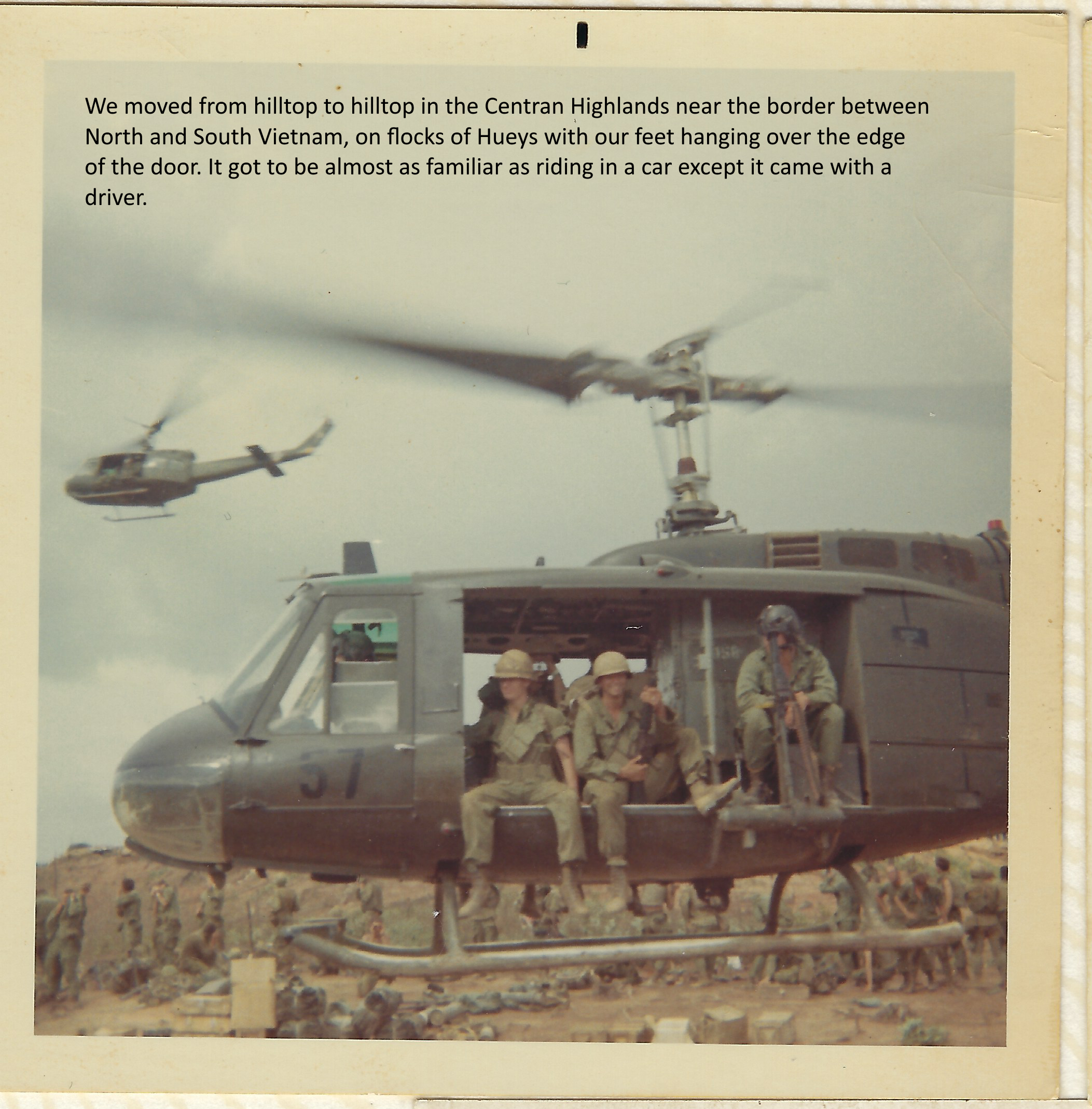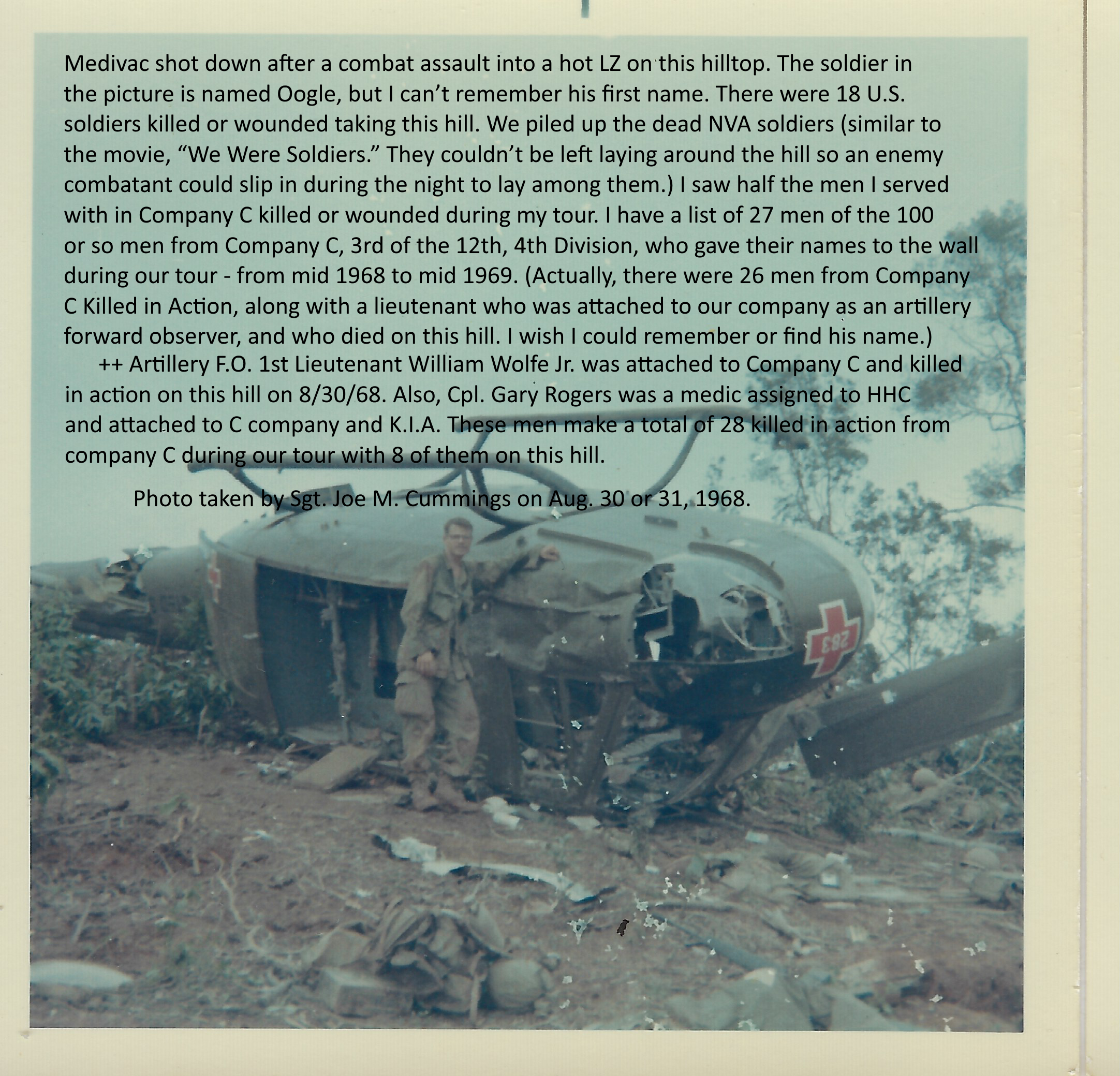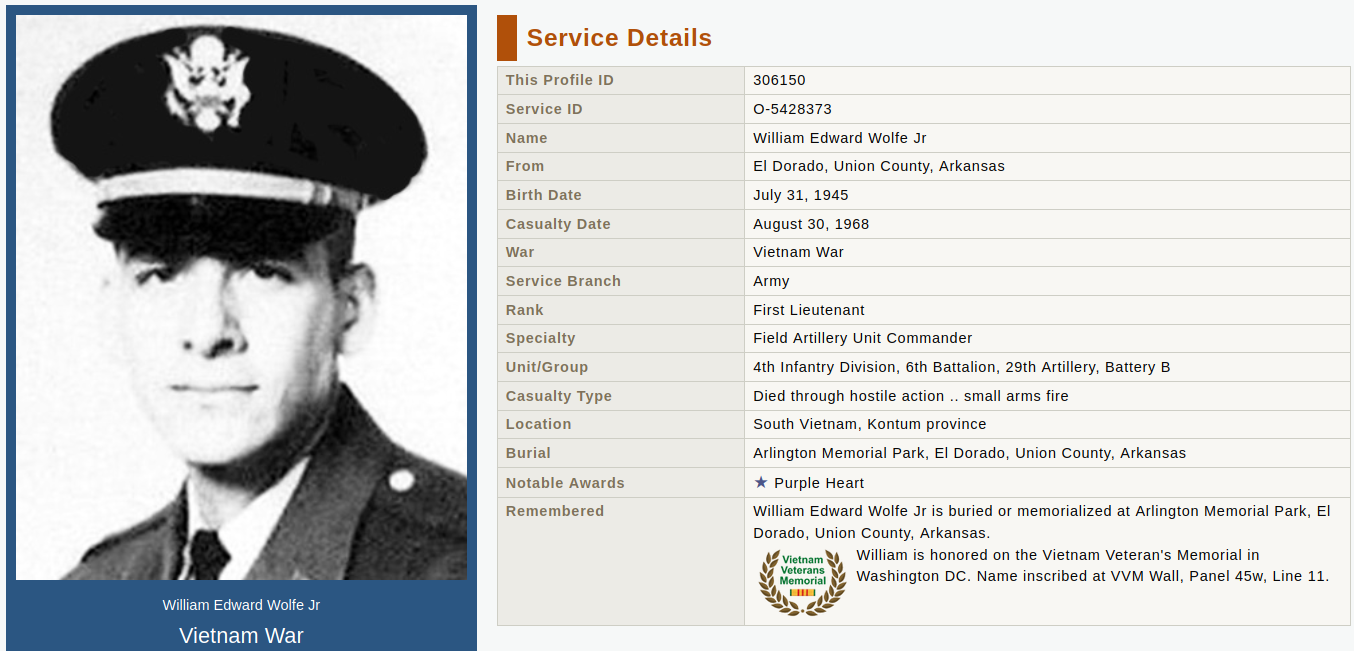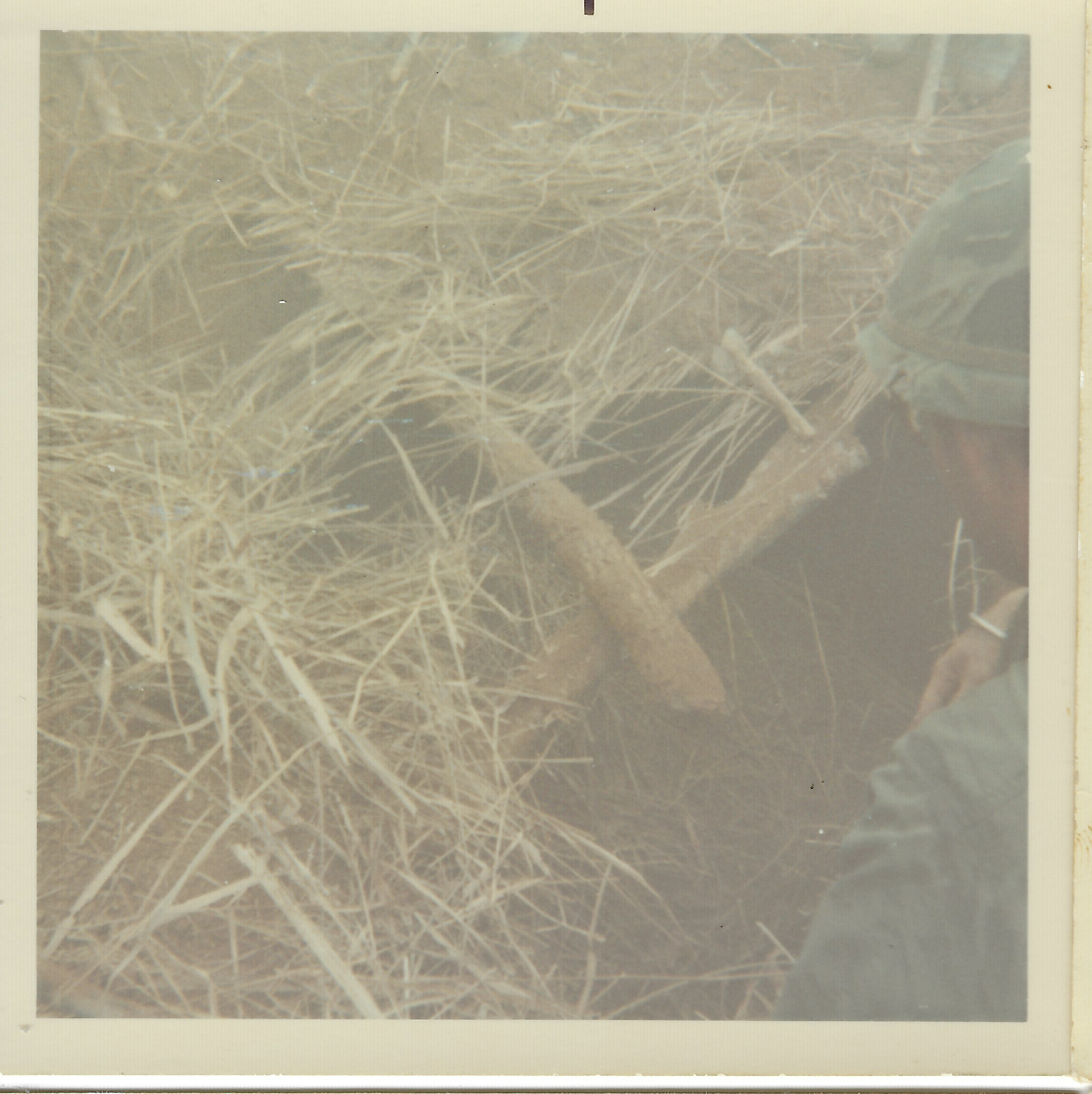
Downed Medivac.
Picture taken by: Sgt. Joe M. Cummings.
Picture taken by: Sgt. Joe M. Cummings.


 After I edited this photo, one of the men I served with told me this action took place on hill 1258. [Hill 1258 and 1338 are examples of numbers used to represent the hills we lived and/or fought on. The number is simply the number of meters tall the hill was.] Hills 1338 and 1258 were ones I had lived on before, but I didn't remember 1258 to be where this combat assault took place. Still... It was a lot of years ago. I have included a photo below of one of the men killed in this battle. I don't have a picture I or one of the men I served with took of William Wolfe; so, I got this one off the net. Lieutenant William Edward Wolfe Jr. was attached to our company as an artillery forward observer a few days after I came in country. [He arrived in the Nam a few days before me, but by the time he got assigned to artillery and then attached to our infantry unit, I was already in the field in Company C.] We quickly became friends. He knew really a lot about the M16-A1 and carried a shortened version he called a carbine. It didn't seem that common to have embedded artillery people with an infantry unit, so, I have wondered since our tour if William was also helping the military evaluate and improve the M16, as, after being attached to our unit, he could bear personal witness to their effectiveness in a combat unit. My friend William was in country just 1 month and 25 days before he was Killed In Action by small arms fire on Aug. 30, 1968, on this Hill 1258.
After I edited this photo, one of the men I served with told me this action took place on hill 1258. [Hill 1258 and 1338 are examples of numbers used to represent the hills we lived and/or fought on. The number is simply the number of meters tall the hill was.] Hills 1338 and 1258 were ones I had lived on before, but I didn't remember 1258 to be where this combat assault took place. Still... It was a lot of years ago. I have included a photo below of one of the men killed in this battle. I don't have a picture I or one of the men I served with took of William Wolfe; so, I got this one off the net. Lieutenant William Edward Wolfe Jr. was attached to our company as an artillery forward observer a few days after I came in country. [He arrived in the Nam a few days before me, but by the time he got assigned to artillery and then attached to our infantry unit, I was already in the field in Company C.] We quickly became friends. He knew really a lot about the M16-A1 and carried a shortened version he called a carbine. It didn't seem that common to have embedded artillery people with an infantry unit, so, I have wondered since our tour if William was also helping the military evaluate and improve the M16, as, after being attached to our unit, he could bear personal witness to their effectiveness in a combat unit. My friend William was in country just 1 month and 25 days before he was Killed In Action by small arms fire on Aug. 30, 1968, on this Hill 1258.
 A little about life in Company C... Our life was not like those making up the majority of Grunts [infantry soldiers] who served. Most of them provided security and ran missions out of Base Camp [BC] during the day, and returned inside the BC perimeter at night; or at least returned every two or three days. Base Camp meant hot showers and warm food and cold beer. We in Company C almost never saw Base Camp. We were part of a small percentage of infantry soldiers that "lived" our year of service out in the jungles of Vietnam on isolated "field forward firebases." I saw 4th Division Base Camp [Camp Ernie I think, at Pleiku] when I came in country, when I rotated home, and when I went out of country for my R&R and came back. Our company existed independently as a field forward firebase, which just meant our 80 to 100 man company spent our lives dug in on the top of some hill, moving our "firebase" often from hilltop to hilltop; to wherever they suspected or had reports of enemy movement. There were few nights that fell that didn't see us with at least a fighting position [holes in the ground with overhead cover if possible] for every man on the hill to get below ground level. We had to be prepared at all times to call in mortars or artillery or air strikes or mini gun spray "danger close" to us or even directly on our own position. When that need came, everyone who would expect to survive had to be able to get below ground level. There were usually no roads in sight in any direction. We navigated and kept track of our location using a compass and a topographical map [a map that included elevation], orienting ourselves only by surrounding hilltops and terrain. Knowing precisely where we were was imperative because that is how we directed artillery or other fire support. When we moved, we walked through the jungle with everything we had on our back. Our weapon and ammunition [about 21 pounds], along with the food and water and gear we carried on a move, often weighed nearly 100 pounds. Nothing says exercise like humping [a term created to describe an infantry soldier carrying all he owned on his back as he moved] a few klicks [kilometers] through the Jungle carrying 100 pounds of gear. Let me just say, it was a brutal life in every conceivable way!
The men you see in these pictures were warriors. That's not to say they were mean or aggressive, or even wanted to be there. Most of us were drafted. Still, when they found themselves part of our little "field forward firebase," even in the face of the 60% loss percentages being suffered, they dug in and kept going in support of our nation and each other. The above picture of the downed medivac is one of only two of such pictures displayed. [I didn't take carnage photos. Maybe I should have documented it all...] Most of the photos were obviously taken "off" times, when we had a short break; taken to send home to our family and friends. Another thing about these men: Most all of them are gunfighters. And again, not to imply they wanted or chose to own such a label. They were forced to be! From memory, we had what averaged about one firefight per month. It is unlikely many of the men of Company C could have survived our year long tour of duty without having to use their weapon to defend themselves. One Company Commander told me it took a dozen Army soldiers working behind the scenes in support for every one of us who put boots on the ground in those field forward firebases. [Those 12 who had other jobs worked as cooks and clerks and drivers and base camp support, etc. They were among those men and women who made up the group living in danger and suffering 3 or 4 percent Killed In Action.] It was and remains my personal belief they needed to "build" companies to do the job we did; companies comprised of men they knew would fight; which meant they had to have "seen" combat. With only a 1 year long tour, that meant it had to happen fast. Having a green company of men attacked, who had never seen a firefight, would prove disastrous. It takes a bit to adjust to being able to function with people trying to kill you; while some of your friends are dying around you. I think ours was one of the companies they kept in as much combat as they could maneuver us into, because we were tempered from previous combat and because they were using our Company C as a crucible firing new combat soldiers, quickly tempering new men as they joined the unit. One man I was close friends with, [Wayne Shadel], said he served a few months with our unit and then, probably based on the experience and abilities he gained, was moved to another company as a squad leader. As you think of these men who became survivors of Company C, remember, they were loyal. Our job was to exist in the jungle along the communist resupply and reinforcement routes coming down from the North into South Vietnam. The military strategy and effort was simply to maneuver us into contact with NVA regular army elements every time they could. Since we were used as the lens focusing artillery and air support, the bigger the enemy unit they could "bump" us into, the better [in the minds of the strategists, of course, not in he mind of most of us]. That was our Vietnam tour of duty and mission. It was costly and it was dangerous.
A little about life in Company C... Our life was not like those making up the majority of Grunts [infantry soldiers] who served. Most of them provided security and ran missions out of Base Camp [BC] during the day, and returned inside the BC perimeter at night; or at least returned every two or three days. Base Camp meant hot showers and warm food and cold beer. We in Company C almost never saw Base Camp. We were part of a small percentage of infantry soldiers that "lived" our year of service out in the jungles of Vietnam on isolated "field forward firebases." I saw 4th Division Base Camp [Camp Ernie I think, at Pleiku] when I came in country, when I rotated home, and when I went out of country for my R&R and came back. Our company existed independently as a field forward firebase, which just meant our 80 to 100 man company spent our lives dug in on the top of some hill, moving our "firebase" often from hilltop to hilltop; to wherever they suspected or had reports of enemy movement. There were few nights that fell that didn't see us with at least a fighting position [holes in the ground with overhead cover if possible] for every man on the hill to get below ground level. We had to be prepared at all times to call in mortars or artillery or air strikes or mini gun spray "danger close" to us or even directly on our own position. When that need came, everyone who would expect to survive had to be able to get below ground level. There were usually no roads in sight in any direction. We navigated and kept track of our location using a compass and a topographical map [a map that included elevation], orienting ourselves only by surrounding hilltops and terrain. Knowing precisely where we were was imperative because that is how we directed artillery or other fire support. When we moved, we walked through the jungle with everything we had on our back. Our weapon and ammunition [about 21 pounds], along with the food and water and gear we carried on a move, often weighed nearly 100 pounds. Nothing says exercise like humping [a term created to describe an infantry soldier carrying all he owned on his back as he moved] a few klicks [kilometers] through the Jungle carrying 100 pounds of gear. Let me just say, it was a brutal life in every conceivable way!
The men you see in these pictures were warriors. That's not to say they were mean or aggressive, or even wanted to be there. Most of us were drafted. Still, when they found themselves part of our little "field forward firebase," even in the face of the 60% loss percentages being suffered, they dug in and kept going in support of our nation and each other. The above picture of the downed medivac is one of only two of such pictures displayed. [I didn't take carnage photos. Maybe I should have documented it all...] Most of the photos were obviously taken "off" times, when we had a short break; taken to send home to our family and friends. Another thing about these men: Most all of them are gunfighters. And again, not to imply they wanted or chose to own such a label. They were forced to be! From memory, we had what averaged about one firefight per month. It is unlikely many of the men of Company C could have survived our year long tour of duty without having to use their weapon to defend themselves. One Company Commander told me it took a dozen Army soldiers working behind the scenes in support for every one of us who put boots on the ground in those field forward firebases. [Those 12 who had other jobs worked as cooks and clerks and drivers and base camp support, etc. They were among those men and women who made up the group living in danger and suffering 3 or 4 percent Killed In Action.] It was and remains my personal belief they needed to "build" companies to do the job we did; companies comprised of men they knew would fight; which meant they had to have "seen" combat. With only a 1 year long tour, that meant it had to happen fast. Having a green company of men attacked, who had never seen a firefight, would prove disastrous. It takes a bit to adjust to being able to function with people trying to kill you; while some of your friends are dying around you. I think ours was one of the companies they kept in as much combat as they could maneuver us into, because we were tempered from previous combat and because they were using our Company C as a crucible firing new combat soldiers, quickly tempering new men as they joined the unit. One man I was close friends with, [Wayne Shadel], said he served a few months with our unit and then, probably based on the experience and abilities he gained, was moved to another company as a squad leader. As you think of these men who became survivors of Company C, remember, they were loyal. Our job was to exist in the jungle along the communist resupply and reinforcement routes coming down from the North into South Vietnam. The military strategy and effort was simply to maneuver us into contact with NVA regular army elements every time they could. Since we were used as the lens focusing artillery and air support, the bigger the enemy unit they could "bump" us into, the better [in the minds of the strategists, of course, not in he mind of most of us]. That was our Vietnam tour of duty and mission. It was costly and it was dangerous.

